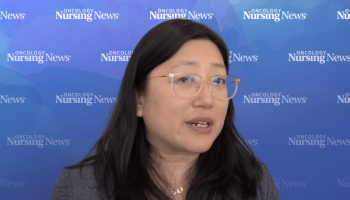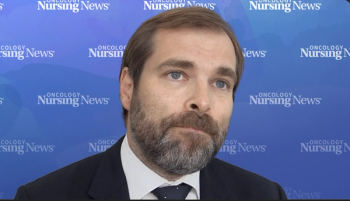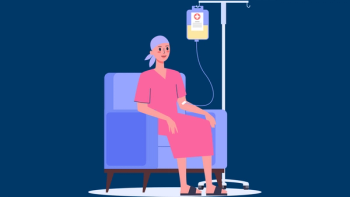
Everolimus plus lanreotide resulted in a progression-free survival of 29.7 months in patients with gastroenteropancreatic neuroendocrine tumors, compared with 11.5 months with everolimus monotherapy.

Everolimus plus lanreotide resulted in a progression-free survival of 29.7 months in patients with gastroenteropancreatic neuroendocrine tumors, compared with 11.5 months with everolimus monotherapy.

Adding E-602 to cemiplimab demonstrated anti-tumor effects in patients PD-L1–resistant solid cancers.

Mitazalimab combined with mFOLFIRINOX led to responses and survival benefits in patients with metastatic pancreatic ductal adenocarcinoma.

The novel drug SHR-A1921 was safe and efficacious in patients with platinum-resistant ovarian cancer, according to phase 1 data.

Docetaxel was associated with lower rates of peripheral neuropathy compared with paclitaxel for Black patients with breast cancer.

NT-17, a long-acting IL-7 agent, enhances CAR T-cell factors associated with efficacy in patients with relapsed/refractory DLBCL when administered 21 days post-CAR T infusion.

Oncology nurses should inform patients about adverse events and the signs of interstitial lung disease before treating their breast cancer with T-DXd.

Distant relapse-free survival was maintained with non-operative management of pMMR locally advanced rectal cancer.

Belrestotug plus dostarlimab-gxly improved ORR in patients with previously untreated, unresectable, locally advanced or metastatic, PD-L1–high NSCLC.

Patients with metastatic castration-resistant prostate cancer who received radium-223 prior to docetaxel had better quality of life and tolerability scores than those who received docetaxel first.

Adagrasib outperformed docetaxel in patients with KRAS G12C-mutated non–small cell lung cancer, regardless of baseline brain metastases.

Earlier switch to atezolizumab after run-in with vemurafenib plus cobimetinib showed promise in improving OS rates in BRAF V600–positive melanoma.

Guiding treatment via response predictive subtype could be beneficial for identifying patients with high-risk breast cancer who may respond to Dato-DXd plus durvalumab.

Pembrolizumab led to improved survival over ipilimumab in patients with unresectable advanced melanoma, according to long-term data.

NKT2152, a novel HIF2a inhibitor, demonstrates significant efficacy in patients with advanced clear cell renal cell carcinoma.

Trastuzumab deruxtecan improved time to deterioration for pain and other categories, in patients with HER2 low/ultralow breast cancer.

Nivolumab, given with or without ipilimumab, showed durable 10-year survival outcomes in patients with advanced melanoma.

Breastfeeding is feasible for patients with hormone receptor–positive breast cancer who are undergoing a break of endocrine therapy.

Datopotamab deruxtecan(Dato-DXd) demonstrated antitumor activity in patients with advanced/metastatic ovarian or endometrial cancer who had prior chemotherapy treatment.

Zipalertinib was safe and effective for heavily pretreated patients NSCLC harboring EGFR exon 20 insertion mutations who progressed on or after amivantamab.

Amivantamab plus chemotherapy delivered promising OS trends compared with chemotherapy in EGFR-mutant advanced non-small cell lung cancer after disease progression on osimertinib.

The duo of TAR-200 and cetrelimab was safe and efficacious in the neoadjuvant setting for certain patients with muscle-invasive bladder cancer.

Adding relatlimab to nivolumab and chemotherapy improved efficacy but did not increase safety concerns in advanced-stage lung cancer.

For patients with early breast cancer, hypofractionated radiation was noninferior to normofractionated radiation regarding lymphedema risk.

Presurgical durvalumab plus chemotherapy, followed by adjuvant durvalumab, led to improved survival in patients with cisplatin-eligible muscle-invasive bladder cancer (MIBC).

Patients with early-stage triple-negative breast cancer tended to have improved survival with neoadjuvant pembrolizumab plus chemo followed by adjuvant pembrolizumab.

Patients with Claudin-6–positive advanced solid tumors, including platinum-resistant ovarian cancer, tended to respond to therapy with TORL-1-23

While adjuvant pembrolizumab and chemotherapy with or without radiation did not boost DFS in the overall high-risk endometrial cancer population, but showed a trend toward improved DFS in one patient subgroup.

Retifanlimab plus carboplatin and paclitaxel boosted PFS for certain patients with recurrent or metastatic SCAC.

The addition of radium-223 to enzalutamide led to significant rPFS and OS benefits compared to enzalutamide alone in metastatic castration-resistant prostate cancer.